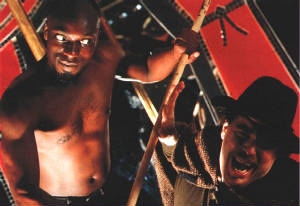|
|
|
|
Der Ring Gott Farblonjet
Review of Der Ring Gott
Farblonjet
by Charles Ludlam (2001) - Tim Cusack, Director
by Martin Denton, NYTheatre.com
This is interactive theatre taken to a new level: the audience troops around the
various playing spaces within Show World, encountering new locales and scenes at every turn. Some of the areas are air conditioned,
some are not; some have ample seating, some do not; some afford close contact with the performers, some require you to strain
your neck and ears to follow what's going on. And yet it works: in a show about sensibilities and perceptions, atmosphere and style
are everything: there probably is no better venue for Der Ring Gott Farblonjet, in spite of--and indeed because of--all
the inconvenience of this one. Cusack's challenge--no mean one--is to try to recreate the experience of ridiculous theatre
for a Y2K audience. When Ludlam first staged this subversive text some twenty-odd years ago, gender-bending, partial nudity,
kitschy pop culture references, and hip irony were novel; now they're practically passť. How then to capture the sensation
(a carefully chosen word) of the ridiculous for a contemporary audience? Cusack's solution is a full-frontal assault of convention-flouting theatrics, some
inventive, some just cheap. Abundance and ambition are the hallmarks of this production: the mere act of coordinating the
eight- or ten-ring circus that is this Ring would defeat Cameron Mackintosh's most trusted underlings. The Rhine maidens
are scantily clad trans- (or de-) gendered go-go dancers a la The Donkey Show; chief god Two-Ton is a larger-than-life
ringer for the Phantom of the Opera; his wife Fricka is a sequined, wigged RuPaul-esque drag queen giant(ess). Scenes unfold
on top of billiard tables and behind what obviously was once a cocktail lounge bar; special effects range from a tacky fireplace
video (for the circle of fire surrounding the sleeping Brunhilde) to a Fisher Price toy rocking horse. Does it work? On one level it does, absolutely: the anarchic spirit of Ludlam and
his contemporaries is very much channeled here: though he starts to run out of ideas near the end of the piece, Cusack surprises
us with happy regularity. On the other hand, lots of stuff in Der Ring falls flat, mostly because its capacity to startle
ore even amuse us has been lost with the passage of time. Robbed of its merrily subversive political subtext, how resonant
can Der Ring really be? Cusack takes several supporting roles in the festivities, acquitting himself nicely
in each one. Ian Hill, as Two-Ton, is also effective, as are Peter Brown as a buttoned-up Alverruck the Dwarf, Xavier Smith
as an improbable Sieglinda, and Matthew Pritchard as ethereally gay versions of Loge (god of fire) and a magic bird. Other
cast members are game, and, if their characterizations are less polished, they're always in the right costume and the right
room at the right time. With this show, that's no mean feat.
|
||||||||||||
|
|
|
|||||||||||
|
Home | About Us | Past Productions | TAYPE | Support Us | Contact Us Theatre Askew Inc. ©
2006
PO Box 1603 Cooper Station
New York, NY 10276 A 501 (C) (3) Corporation
Site design courtesy of
PMM LLC
|
||||||||||||


